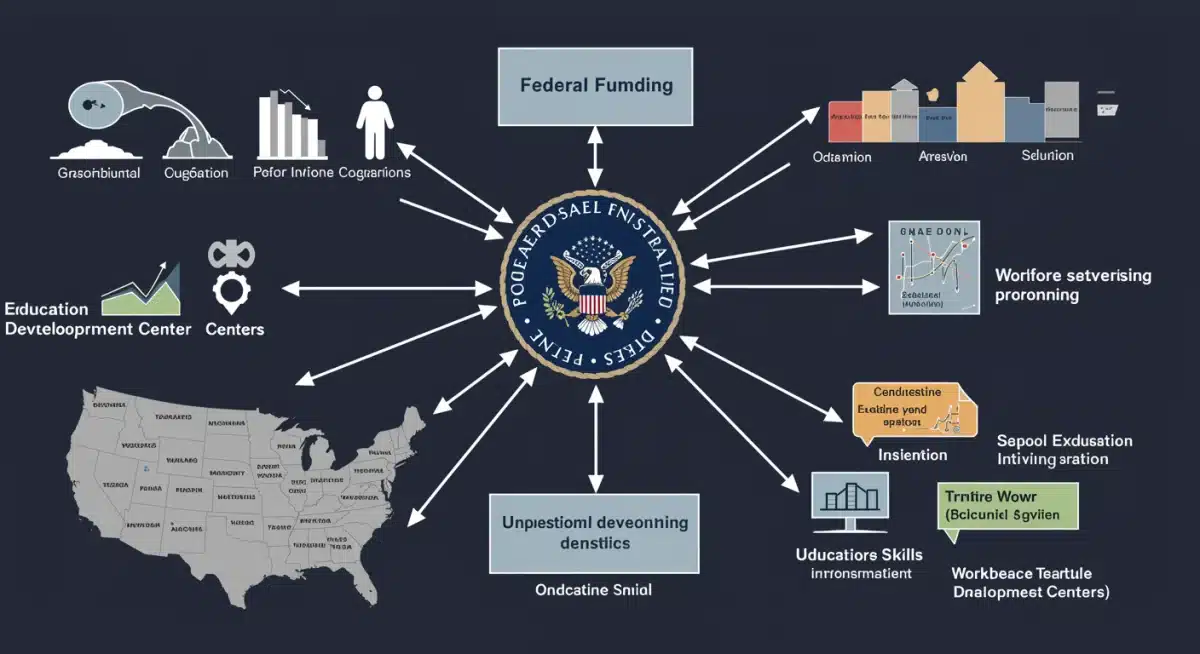Federal Investment in Digital Skills: 2025 U.S. Worker Opportunities

Latest developments on Federal Investment in Digital Skills Training: How U.S. Workers Can Access 2025 Opportunities (RECENT UPDATES) with key facts, verified sources, and what readers need to monitor next in Estados Unidos, presented clearly in Inglês (Estados Unidos) (en-US).
Federal Investment in Digital Skills Training: How U.S. Workers Can Access 2025 Opportunities (RECENT UPDATES) is shaping today’s agenda with new details emerging from officials and industry sources. This update prioritizes what changed, why it matters, and what to watch next, in a clear news format.
Understanding the Current Landscape of Federal Digital Skills Investment
The U.S. government is intensifying its focus on workforce development, particularly in digital skills, recognizing its critical role in national competitiveness and economic growth. Recent legislative actions and budgetary allocations underscore a commitment to prepare American workers for the demands of a rapidly evolving digital economy. This section delves into the foundational aspects of this federal push.
The Biden-Harris administration has consistently championed initiatives aimed at bolstering the nation’s technological prowess. This includes significant funding channeled through various departments to create accessible training pathways. The goal is to ensure that a broad spectrum of the American workforce, from entry-level to experienced professionals, can acquire or upgrade essential digital competencies.
Key Legislative Frameworks and Funding Streams
Several acts and programs form the bedrock of this federal investment. Understanding these frameworks is crucial for identifying where opportunities originate and how they are structured.
- Workforce Innovation and Opportunity Act (WIOA): This landmark legislation remains a primary vehicle for funding workforce development, including digital skills training, through state and local programs.
- CHIPS and Science Act: Beyond semiconductor manufacturing, this act allocates substantial resources for STEM education and workforce development, directly impacting digital skills in critical technology sectors.
- American Rescue Plan Act (ARPA): While primarily a COVID-19 relief measure, ARPA funds have been utilized by states and localities to invest in workforce training, including digital literacy and advanced tech skills, to aid economic recovery.
- Department of Labor (DOL) Grants: The DOL regularly issues grants for sector-specific training programs, many of which focus on digital transformation and emerging technologies.
These legislative and funding mechanisms are designed to create a robust ecosystem for digital upskilling and reskilling. The emphasis is on programs that lead to recognized credentials, industry certifications, and direct employment opportunities.
The current landscape indicates a strategic alignment between federal policy and industry needs. By understanding these core components, U.S. workers can better navigate the available resources and position themselves for future success in the digital realm.
Accessing 2025 Digital Skills Training Opportunities: What Workers Need to Know Now
For U.S. workers aiming to leverage federal investment in digital skills, understanding the actionable steps and available resources is paramount. 2025 is poised to be a pivotal year, with numerous programs becoming more established and accessible. This section outlines how individuals can proactively engage with these opportunities.
The federal government typically works through a network of state and local entities, as well as educational institutions and non-profit organizations, to deliver training. Direct federal programs for individuals are less common than grants or funding directed to these intermediary bodies. Therefore, knowing where to look locally is key.
Identifying Relevant Programs and Pathways
Finding the right training program starts with assessing current skill levels and career aspirations. Digital skills encompass a wide range, from basic digital literacy to advanced cybersecurity and AI proficiency.
- Local Workforce Development Boards (WDBs): These boards are excellent first points of contact. They administer WIOA funds and can connect individuals to local training providers, career counseling, and job placement services.
- Community Colleges and Universities: Many higher education institutions partner with federal and state initiatives to offer short-term certificate programs, bootcamps, and degree pathways in high-demand digital fields.
- Non-profit Organizations and Industry Associations: Groups like Per Scholas, Year Up, and various tech industry associations often receive federal or state funding to provide specialized training and apprenticeships.
- Online Learning Platforms: While not directly federal, some federal programs may subsidize enrollment in reputable online courses from platforms like Coursera, edX, or Udacity, especially in partnership with educational institutions.
It is crucial for workers to research specific program requirements, which often include residency, income, or prior educational criteria. Many programs are designed to support underserved populations, veterans, and individuals transitioning from declining industries.
For 2025, expect a continued emphasis on skills aligned with emerging technologies such as artificial intelligence, data science, cloud computing, and cybersecurity. These areas are consistently highlighted in federal reports as critical for future economic resilience.
Recent Updates and Policy Shifts Impacting 2025
The landscape of federal investment is dynamic, with ongoing policy adjustments and new initiatives continually being introduced. Staying abreast of these recent updates is essential for anticipating changes in program availability and focus for 2025. This section highlights key shifts and announcements.
Just in the past year, there have been several significant developments. For instance, the Department of Commerce has launched new programs under the CHIPS and Science Act, specifically targeting workforce development in advanced manufacturing and semiconductor industries, which inherently require strong digital skills.

Emerging Federal Priorities for Digital Training
Federal agencies are increasingly prioritizing certain digital skill areas, reflecting national security and economic competitiveness concerns. These priorities often translate into targeted funding opportunities.
- Cybersecurity Workforce Development: With escalating cyber threats, federal investment in cybersecurity training is at an all-time high, supporting initiatives from K-12 education to professional certifications.
- AI and Machine Learning Literacy: As artificial intelligence integrates across sectors, programs are emerging to train workers in AI fundamentals, ethical AI, and practical application.
- Green Technology Digital Skills: The push towards a sustainable economy also requires digital proficiencies in areas like smart grid management, renewable energy system analytics, and climate modeling.
- Digital Equity and Inclusion: A strong emphasis remains on ensuring that all Americans, regardless of background or geographic location, have access to digital literacy and advanced skills training.
Additionally, federal agencies are exploring innovative models for skill acquisition, including competency-based education and micro-credentials, which allow workers to quickly gain specific, in-demand skills. Partnerships between government, industry, and academia are also becoming more formalized to ensure training curricula are directly relevant to employer needs.
Workers should monitor official government websites, such as those for the Department of Labor, Department of Education, and Department of Commerce, for the latest grant announcements and program guidelines. These updates often provide the earliest indicators of where federal training dollars are being directed for the upcoming year.
Impact on U.S. Workforce and Economic Growth
The strategic federal investment in digital skills training is not merely about individual upskilling; it’s a foundational strategy for strengthening the entire U.S. workforce and fostering sustained economic growth. These initiatives aim to close critical skill gaps, enhance productivity, and ensure American leadership in global innovation. The ripple effect extends across various industries.
By equipping workers with advanced digital competencies, the nation becomes more resilient to technological disruptions and better positioned to capitalize on emerging opportunities. This proactive approach helps mitigate potential job displacement due to automation and creates pathways to higher-paying, future-proof careers.
Boosting Industry Competitiveness and Innovation
A digitally proficient workforce directly translates into increased innovation and competitiveness for U.S. industries. Companies can adopt new technologies more rapidly, develop cutting-edge products and services, and expand into new markets.
- Increased Productivity: Workers with modern digital skills can leverage tools and platforms more effectively, leading to greater efficiency and output.
- Enhanced Innovation: A workforce skilled in areas like AI, data analytics, and software development fuels research and development, driving new discoveries and commercial applications.
- Attracting Foreign Investment: A highly skilled talent pool makes the U.S. an attractive destination for global businesses looking to establish or expand operations.
- Strengthening Supply Chains: Digital skills are crucial for optimizing logistics, managing complex data, and securing critical infrastructure within supply chains.
The long-term vision is a robust economy where every American has the opportunity to participate meaningfully in the digital age. This federal commitment underscores the belief that investing in human capital, particularly in digital capabilities, is the most effective way to secure future prosperity.
Furthermore, an upskilled workforce leads to higher wages and improved living standards, contributing to a stronger consumer economy. The federal government recognizes that these investments yield significant returns, not just for individuals, but for the entire nation.
Navigating Application Processes and Eligibility Criteria
Once a worker identifies potential digital skills training programs, the next critical step involves understanding and successfully navigating the application processes and eligibility criteria. These can vary significantly depending on the funding source and the specific program. Patience and thoroughness are key to securing these valuable opportunities.
Most federally funded programs require applicants to meet certain conditions, which might include residency in a particular state or county, proof of U.S. citizenship or legal work authorization, and sometimes income-level verification. These criteria ensure that resources are directed to the intended beneficiaries.

Common Eligibility Requirements and Documentation
While specific requirements differ, several common elements typically appear in applications for federally supported digital skills training.
- Residency Verification: Proof of residence (e.g., utility bills, state ID) in the area served by the program.
- Proof of Identity and Work Eligibility: U.S. passport, birth certificate, green card, or other documents proving legal ability to work in the U.S.
- Educational Background: Transcripts or diplomas may be required, especially for advanced programs. Some programs target individuals without college degrees to provide new pathways.
- Income Verification: Many programs prioritize low-income individuals or those who are unemployed/underemployed. Documentation may include tax returns, pay stubs, or unemployment benefit statements.
- Enrollment in Selective Service: For male applicants between 18 and 25, proof of Selective Service registration is often required.
It is advisable to gather all necessary documentation before starting an application to streamline the process. Many workforce centers and program administrators offer assistance with applications, including help with compiling required documents and understanding complex forms.
Additionally, some programs may involve an assessment of foundational skills or a basic aptitude test to ensure candidates are well-suited for the rigor of digital training. Being prepared for these steps can significantly improve a worker’s chances of acceptance and successful completion.
The Future Outlook: Sustained Federal Commitment and Evolution
Looking beyond 2025, the trajectory of federal digital skills investment indicates a sustained, evolving commitment rather than a temporary initiative. Policymakers across the aisle recognize the imperative of a digitally competent workforce for national security, economic prosperity, and global leadership. This long-term view suggests that opportunities for U.S. workers to acquire and enhance digital skills will continue to expand and adapt.
The focus is shifting towards anticipating future skill demands, not just reacting to current shortages. This involves greater collaboration between government, industry, and educational institutions to forecast technological trends and design responsive training curricula. The aim is to create a dynamic system that can quickly pivot to address emerging needs, such as those in quantum computing, advanced robotics, and biotech.
Anticipated Trends in Federal Support
Several trends are expected to shape federal digital skills initiatives in the coming years.
- Increased Emphasis on AI and Automation: Training programs will increasingly integrate AI and automation literacy and skills for working alongside automated systems across all sectors.
- Lifelong Learning Models: Federal programs may further support modular, stackable credentials that allow workers to continuously update skills throughout their careers.
- Hybrid Learning Solutions: A blend of online and in-person training will likely become the norm, offering flexibility and accessibility to a wider population.
- Targeted Industry Partnerships: More direct partnerships with leading tech companies and industry consortia are anticipated to ensure training directly aligns with employer needs and job placement.
The federal government is also exploring innovative funding mechanisms, including public-private partnerships and outcomes-based funding, where payments to training providers are tied to successful job placements and retention. This ensures accountability and maximizes the impact of taxpayer dollars.
For U.S. workers, this sustained commitment means that investing in digital skills will remain a viable and supported pathway to career advancement and economic stability for the foreseeable future. Staying informed about these evolving trends will be crucial for capitalizing on upcoming opportunities.
Key Focus Area |
Brief Description |
|---|---|
Primary Funding | WIOA, CHIPS Act, DOL grants underpin digital skills training. |
Access Points |
Local WDBs, community colleges, non-profits are key for enrollment. |
Key Skill Areas |
Cybersecurity, AI, data science, cloud computing are prioritized. |
Future Outlook |
Sustained federal commitment, evolving programs, and industry partnerships. |
Frequently Asked Questions on Federal Digital Skills Investment
The primary goal is to equip the U.S. workforce with essential digital competencies to enhance national competitiveness, foster economic growth, and ensure American leadership in an increasingly technology-driven global economy.
Workers should start by contacting their Local Workforce Development Boards, community colleges, or researching programs offered by non-profit organizations and industry associations that receive federal funding.
Key prioritized skills include cybersecurity, artificial intelligence (AI), data science, cloud computing, and advanced manufacturing technologies, reflecting critical national needs and industry demands.
Yes, most programs have eligibility criteria such as residency, U.S. work authorization, and sometimes income levels. Specific requirements vary by program and are detailed by the administering organizations.
The long-term outlook is a sustained and evolving commitment. Federal support is expected to continue adapting to future technological trends, emphasizing lifelong learning and strong public-private partnerships.
What this means
The ongoing federal investment in digital skills training represents a critical juncture for U.S. workers. It underscores a strategic national effort to future-proof the workforce and maintain economic competitiveness. As 2025 approaches, individuals must proactively seek out and engage with the myriad of programs available through local workforce boards, community colleges, and specialized non-profits. The focus on high-demand areas like cybersecurity and AI signals where the most significant opportunities lie. This commitment is not fleeting; it’s a foundational shift towards equipping every American with the tools to thrive in the evolving digital economy, demanding continuous attention to new program announcements and policy adjustments.





